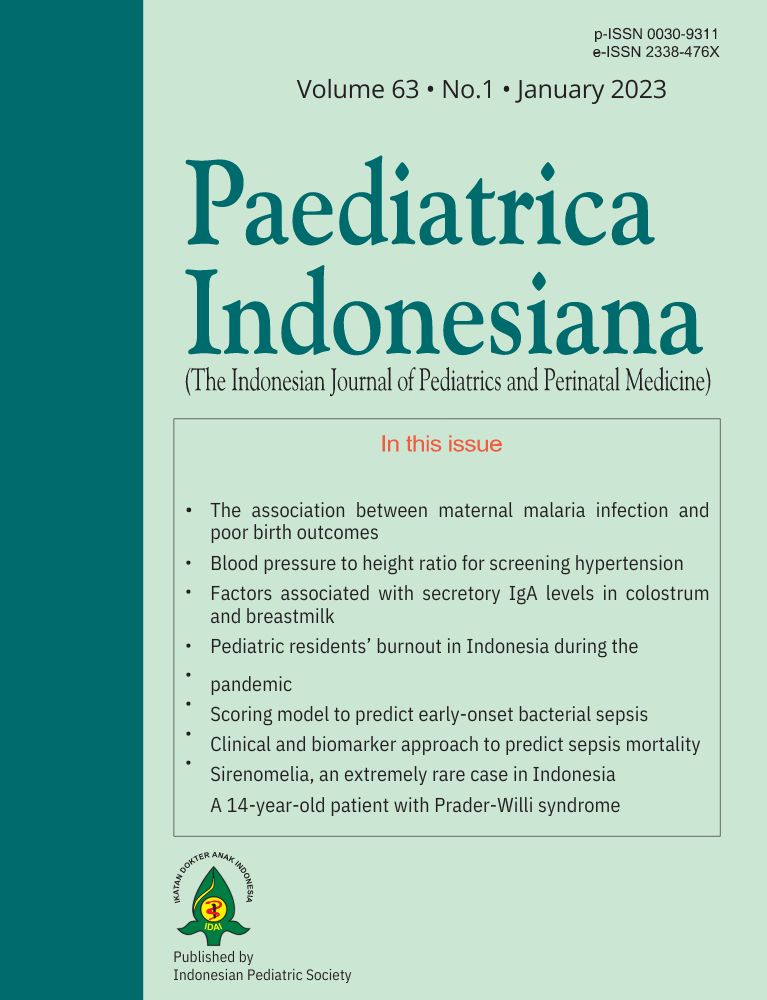Sirenomelia or “mermaid syndrome”: an extremely rare case in Indonesiasia
Abstract
Sirenomelia, also known as mermaid syndrome, is a very rare lethal congenital disorder with multisystem malformations, characterized by fusion of the lower limbs. Here we report a preterm neonate with fusion of the lower limbs. The baby was born by cesarean section to a 27-year-old primigravida mother at 35 weeks and 3 days’ gestation. There was no maternal history of hypertension, heart disease, asthma, or diabetes mellitus. At birth, the infant did not cry, had weak tone, a heart rate (HR) of <60 beats per minute (BPM), an Apgar score of 1/2, and a birth weight of 2,300 grams. The infant had an imperforate anus and no urogenital openings or external genitalia. There was a small penis-like protrusion without an aperture, such as in cases of ambiguous genitalia. The two lower limbs were fused, with five toes on each foot. Despite neonatal resuscitation, the infant died within 75 minutes of birth. The child was diagnosed with sirenomelia. This case report aims to emphasize the importance of early prenatal diagnosis and education of the patient’s family.
References
2. Kanagagiri, Suryaprakash, Singh YT, Singh KS. Sirenomelia apus – a case report. J Med Sci Clin Res. 2017;5:24993-6. DOI: https://doi.org/10.18535/jmscr/v5i7.113.
3. Garrido-Allepuz C, Haro E, González-Lamuño D, Martínez-Frías ML, Bertocchini F, Ros MA. A clinical and experimental overview of sirenomelia: insight into the mechanisms of congenital limb malformations. Dis Model Mech. 2011;4:289-99. DOI: 10.1242/dmm.007732.
4. Valenzano M, Paoletti R, Rossi A, Farinini D, Garlaschi G, Fulcheri E. Sirenomelia. Pathological features, antenatal ultrasonographic clues, and a review of current embryogenic theories. Hum Reprod Update. 1999;5:82–6. DOI: https://doi.org/10.1093/humupd/5.1.82.
5. Reddy KR, Srinivas S, Kumar S, Reddy S, Prasad H, Irfan GM. Sirenomelia: a rare presentation. J Neonatal Surg. 2012;1:7.
6. Martinez-Frias ML, Garcia A, Bermejo E. Cyclopia and sirenomelia in a liveborn infant. J Med Genet. 1998;35:263–4. PMID: 26023366.
7. Pal S, Biswas R, Danda D, Chattopadhyay JC, Danda TK. Sirenomelia: mermaid syndrome. Int J Anat Res. 2014;2:689-91. DOI: https://doi.org/10.16965/ijar.2014.526.
8. Semba K, Yamamura K. Etiology of caudal regression syndrome. Human Genet Embryol. 2013;(3):107. DOI: https://doi.org/10.4172/2161-0436.1000107.
9. Al Hadhoud F, Kamal AH, Al Anjari A, Fe Diejomaoh M. Fusion of lower limbs with severe urogenital malformation in a newborn, a rare congenital clinical syndrome: case report. Int Med Case Rep J. 2017;10:313–7. DOI: https://doi.org/10.2147/IMCRJ.S139067.
10. Sutopo M and Uli T. “The mermaid syndrome“ - kasus serial. Cermin Dunia Kedokteran. 2017; 44(5): 337-8. DOI: https://doi.org/10.55175/cdk.v44i5.799.
11. Arora G, Bagga GR, Nandu VV. A rare case of twin gestation with sirenomelia and a coexisting normal fetus. J South Asian Feder Obst Gynae. 2017;9:360-2. DOI: https://doi.org/10.5005/jp-journals-10006-1529.
12. Kumar Y, Gupta N, Hooda K, Sharma P, Sharma S, Kochar P, et al. Caudal regression syndrome: a case series of a rare congenital anomaly. Pol J Radiol. 2017;82:188-92. DOI: https://doi.org/10.12659/PJR.900971.
13. Contu R, Zoppi MA, Axiana C, Ibba RM, Monni G. First trimester diagnosis of sirenomelia by 2D and 3D ultrasound. Fetal Diagn Ther. 2009;26:41–4. DOI: https://doi.org/10.1159/000236359.
14. Lynch SA, Wright C. Sirenomelia, limb reduction defects, cardiovascular malformation, renal agenesis in an infant born to a diabetic mother. Clin Dysmorphol. 1997;6:75–80. PMID: 9018422
15. Stocker JT, Heifetz SA. Sirenomelia. A morphological study of 33 cases and review of the literature. Perspect Pediatr Pathol. 1987;10:7–50. PMID: 3588246.
16. Taori KB, Mitra K, Ghonga NP, Gandhi RO, Mammen T, Sahu J. Sirenomelia sequence (mermaid: report of three cases. Indian J Radiol Imaging. 2002;12:399-401.
17. Pinette MG, Hand M, Hunt RC, Blackstone J, Wax JR, Cartin A. Surviving sirenomelia. J Ultrasound Med. 2005;24:1555–9. DOI: https://doi.org/10.7863/jum.2005.24.11.1555.
Copyright (c) 2023 Qodri Santosa, Setya Dian Kartika; Irwan Nuryadin, Alfi Muntafiah

This work is licensed under a Creative Commons Attribution-NonCommercial-ShareAlike 4.0 International License.
Authors who publish with this journal agree to the following terms:
Authors retain copyright and grant the journal right of first publication with the work simultaneously licensed under a Creative Commons Attribution License that allows others to share the work with an acknowledgement of the work's authorship and initial publication in this journal.
Authors are able to enter into separate, additional contractual arrangements for the non-exclusive distribution of the journal's published version of the work (e.g., post it to an institutional repository or publish it in a book), with an acknowledgement of its initial publication in this journal.

This work is licensed under a Creative Commons Attribution-NonCommercial-ShareAlike 4.0 International License.
Accepted 2023-03-06
Published 2023-03-06












